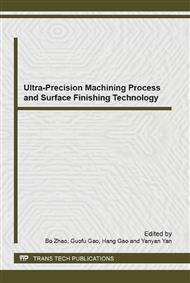[1]
T B Thoe, D K Aspinwall, M L H Wise, Review on ultrasonic machining [J]. International Journal of Mechanical Tools Manu facture, 38 (1988) 239-1418.
Google Scholar
[2]
Y D Zhang, Ultrasonic machining and its application, National defense industry press, Beijing, (1998).
Google Scholar
[3]
T. C. Lee, C. W. Chan, Mechanism of the ultrasonic machining of ceramic composites, Journal of Materials Processing Technology, 71 (1997) 195-201.
DOI: 10.1016/s0924-0136(97)00068-x
Google Scholar
[4]
Y Wu, A W Sun, B Zhao, Study on the Mechanism of Material Removal of Ultrasonic V ibration Grinding of Ceramic, Manufacturing Technology & Machine Journal, 4(2006)59-62.
Google Scholar
[5]
J S Lee, D W Lee, Y H Jung, et al. A study on micro-grooving characteristics of planar light wave circuit and g lass using ultrasonic vibration cutting, Journal of Materials Processing Technology, 130 (2000) 396-400.
DOI: 10.1016/s0924-0136(02)00740-9
Google Scholar
[6]
B Zhao, F Chen, J L Tong, et al. Theoretical and experimental research on material removal rate under ultrasonic grinding, Journal of HeNan Polytechnic University (National Science), 23 (2013) 303-307.
Google Scholar
[7]
M Zhao , X J Wang, B K A Ngoi, et al. Brittle- ductile transition in the diamond cutting of g lasses with the aid of ultrasonic vibration, Journal of Materials Processing Technology, 121 (2002) 243-251.
DOI: 10.1016/s0924-0136(01)01262-6
Google Scholar
[8]
H L Su, R Wang, J Liu, et al. Study on Method and Mechanism of Ultrasonic Grinding of Engineering Ceramics, Coal Mine Machinery, 29 (2008) 84-86.
Google Scholar
[9]
D J Feng, F L Zhao, et al. Mathematic Model of Material Removal Rate for Ultrasonic Milling, Chinese Journal of Mechanical Engineering, 17(2006) 1399-1403.
Google Scholar
[10]
M Zhao, Y Li, et al. Material Removal Rate Model of Ductile Materials in Ultrasonic Machining, Journal of Suzhou University, 45 (2001) 25-28.
Google Scholar
[11]
R Singh, J S Khamb, Ultrasonic machining of titanium and its alloys: A review, Journal of Materials Processing Technology, 173 (2006) 125- 135.
DOI: 10.1016/j.jmatprotec.2005.10.027
Google Scholar
[12]
R Singh, J S Khamb, Investigation for ultrasonic machining of titanium and its alloys, Journal of Materials Processing Technology, 183 (2007) 363-367.
DOI: 10.1016/j.jmatprotec.2006.10.026
Google Scholar


